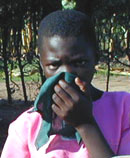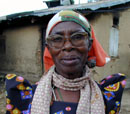Andrew
Maykuth Online
|
 |
Arseni Oworyanawe in the field where his brother buried the bodies. |
RUGAZI, Uganda - Arseni Oworyanawe began to notice strange things a few months ago at his younger brother's house next door - strange even compared with his brother's odd behavior since he joined a religious cult nine years ago.
In December, the younger brother, Dominic Kataribabo, 64, a defrocked Roman Catholic priest educated in the United States, erected a crude fence of reed mats to block the view of the residence. Then Kataribabo began digging holes around the stone-and-brick house.
Oworyanawe dismissed the peculiar behavior until last week, when police exhumed 74 mutilated and strangled bodies from a pit in the backyard. Then investigators found 81 more bodies packed beneath the house, where his brother had claimed that he was installing an underground refrigerator, even though his house has no electricity.
Oworyanawe was not the only one to ignore sinister signs from the doomsday cult known as the Movement for the Restoration of the Ten Commandments of God, whose leaders are believed to be responsible for killing at least 924 cult members in recent months. That toll surpasses the 914 people who died in the Peoples Temple tragedy in Jonestown, Guyana, in 1978, making the deaths in Africa the worst cult killing in modern history.
Information now coming from police investigators and former cult members paints a picture of greed, gullibility and desperate violence.
Police theorize that cult leaders killed hundreds of members to suppress a rebellion within the organization because predictions that the world would end on Jan. 1 were not fulfilled. Members who had turned over their belongings to join the cult had begun to demand refunds.
The Rev. Paul Ikazire, 82, a Catholic priest who joined the cult but quit six years ago after the church decreed the group heretical, said he met a cult member in February who was upset that the doomsday predictions had not come true.
"I suspect he might have asked for his money back," Father Ikazire said. "I think he must be dead now."
The cult leaders apparently worked frantically to kill and bury members to keep the scheme intact. The bodies found in scattered locations appear to have been buried over the course of several months.
Police believe the victims were incapacitated by poison before they were stabbed, strangled or beaten to death.
Peter Ahimbisibwe, 17, was one of the last people to see cult members alive before hundreds were killed in a fire in the sect's chapel in the village of Kanungu. The teenager, who had been brought into the cult by his mother, said the followers were ordered to spend their final week praying, fasting, and cleaning the compound. The leaders said that special visitors were coming.
But on the fateful day, March 17, the young man woke up hungry. Looking to break his fast, he slipped out of the compound at dawn to go home to get something to eat.
His hunger saved his life.
After Ahimbisibwe left, the cult leaders herded the membership into a long, mud-brick building known as the ark. The wooden windows were nailed shut from the outside, and the interior was doused with gasoline.
Around 11 a.m., the fire broke out. Authorities initially reported that at least 330 charred bodies were found inside the ruins. On Friday, they raised the toll to at least 530.
Among the dead were Ahimbisibwe's mother, Noel Gorret, and his sister, Fortunate.
Police have arrested a local official, who was said to be friendly with cult leaders, for allegedly suppressing an intelligence report on the group.
"Some intelligence officers filed reports saying that this is a dangerous group, but at one level it was not forwarded, it was just ignored," Ugandan President Yoweri Museveni said recently.
Local officials also disregarded telltale clues. Police at first assumed
that the cult leaders died with their followers in a mass suicide.
 |
An observer reacts to one of the grave sites. |
A few days later, officials rooting through the cult's compound for buried treasure stumbled across six bodies stuffed into a latrine connected to the cult leaders' house, the first clue that not all the cult members had died willingly.
The discovery led to mass graves at three other properties in this densely populated corner of southwest Uganda where farms cling to mist-shrouded hills, surrounded by forests inhabited by rare mountain gorillas.
This past week, as barefoot convicts exhumed body after body - most of them women and children - there was growing suspicion that the cult leaders did not die in the fire but escaped with the proceeds from the sale of their followers' belongings. A vehicle used by the cult is missing.
During the final weeks inside the 31-acre compound, the cult quickly sold off its most valuable property, including its cows, at steep discounts. The leaders told the public they needed the cash to buy an electrical generator.
The cult already had a reputation for bizarre behavior. Its members wore green robes and were forbidden to speak, so they communicated with hand gestures or in notes. They refrained from sex; men and women slept in separate dormitories. They withdrew their children from public schools, consumed no alcohol or tobacco, and frequently fasted as a form of penitence. The government last year ordered the cult to close its primary school after it found that the children were malnourished.
The cult's leaders - or apostles, as they called themselves - dressed as priests and nuns even though they were denounced by the Catholic Church, to which most of them traced their roots.
The Ten Commandments cult was headed by Joseph Kibwetere, 68, a former schoolteacher, public official and businessman who was so inspired by a 1975 pilgrimage to Rome that he built a Catholic church near his home. Before he joined the cult, Kibwetere attended Mass daily, according to his wife, Theresa Kibwetere, a former teacher who met her husband in 1960 when he was an inspector for the Catholic school system.
Joseph Kibwetere may have been pious, but he was no saint. He had eight children with his wife and eight children with at least three other women.
Theresa Kibwetere raised all 16 children as her own on their farm near Kabumba.
While Kibwetere portrayed himself as a prophet and the group's "bishop," those close to the cult said the real power resided with the cult's second-in-command, Credonia Mwerinde, 40.
Mwerinde sold traditional beer and moonshine at a stand in the village market, where she established a reputation as a prostitute.
In 1988, she claimed she had had a vision of the Virgin Mary, who told her that the world was going to end and Mwerinde could save her soul by rigidly following the Ten Commandments.
The following year, she met Joseph Kibwetere and his wife, who came to a meeting to hear Mwerinde describe her visions. Mwerinde told her audience that she had had a vision to find a man called "Kibwetere," who would help spread her message to the world.
Having found him, Mwerinde, her sister and her niece moved into Kibwetere's home immediately, according to Kibwetere's family. Mwerinde also brought her two children.
When he met Mwerinde, Kibwetere had just finished a failed attempt at politics. Apparently in retaliation for his political impudence, somebody had poisoned his 80 cattle.
"I believe that after losing so much property he reached out to God," said Theresa Kibwetere. She thought her husband was vulnerable to Mwerinde's charms.
"They made him leader," said Giles Musimwe, one of Kibwetere's sons. "They knew he could easily convince the masses to follow. He had a big following, especially with the Catholics."
Mwerinde quickly took control of the Kibwetere household, according to
the Kibweteres. "You see, my husband thought that whatever Credonia
said was the truth," said Theresa Kibwetere. She called Mwerinde
"The Programmer."
 |
Theresa Kibwetere |
Mwerinde and her sister moved into the couple's bedroom - everyone slept on separate mats, Theresa Kibwetere said. At night, Mwerinde or her niece would sometimes awake and shout out that they had experienced a vision or some sort of direct communication with God.
A few weeks later, Joseph Kibwetere also began reporting visions.
Kibwetere introduced Mwerinde to an old friend, Father Kataribabo, who also joined the religious group. They also recruited Father Ikazire, who found the simplicity of their message appealing - that life would be better if people adhered to the Ten Commandments.
But Father Ikazire said he soon became uncomfortable with the cult. The organization seemed to be obsessed with getting members to turn over their possessions. Mwerinde also made more outlandish predictions. She said the world would end in 1992 but amended the prediction later when life went on as usual.
"She said God was so kind to give more time for the people to repent," Father Ikazire said.
He quit the cult in 1994 when the bishop threatened cult members with excommunication from the Catholic Church.
"I saw they were going astray of the bishop and the teaching of the Pope," said Father Ikazire, who lives in Rugazi less than a mile from Kataribabo's house where more than 150 bodies were found. He wrote to Kataribabo in 1994 - in Latin, so the cult members could not read it - to urge him to come back to the church. It was their last contact.
By 1994, Mwerinde and her sister had come to dominate the Kibwetere household, Theresa Kibwetere said. They beat Kibwetere's children, who objected to taking orders. Mwerinde would often go off alone to write her interpretations of the commandments and of her visions.
By that time, the cult had about 200 followers who moved into the Kibwetere's house. Mwerinde banished Kibwetere's children to a stable behind the house while giving her own two children one of the bedrooms inside the house.
Later in 1994, Kibwetere packed up his belongings, took the family car and moved, along with all the cult members, to Mwerinde's family farm outside Kanungu.
All Kibwetere left behind were pictures of himself before he joined the cult and a dozen portraits of the Virgin Mary on the wall.
The last time Theresa Kibwetere saw her husband was in 1995, when he returned for the funeral of one of their sons. He didn't say a word.